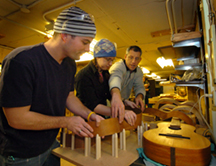
| RELATED INFO |
| * Department of Mechanical Engineering Technology |
| * METAL |
| RELATED NEWS RELEASE |
| * Purdue to offer guitar-making class July 16-20 |

February 28, 2007
Guitar-making class strikes a chord with students
WEST LAFAYETTE, Ind. - |
"I've found this class is a great way to relate to students," said Mark French, an assistant professor of mechanical engineering technology. "They connect with it almost instinctively because it allows them to apply what they learn about physics and acoustics toward the design of a product they are interested in and familiar with. It really cuts through."
The class, called Instrument Manufacturing and Testing, combines a once-a-week lecture with two days in the Mechanical Engineering Technology Acoustics Lab (known as METAL), located in the basement of the Michael Golden Laboratories.
French said the class focuses on guitar manufacturing and testing. He has done extensive study on guitar acoustics and what is known as build variation. In manufacturing, the goal is to have as little build variation as possible so each product is consistent and quality is maintained. In an instrument such as a guitar, reducing build variation is important to ensure that each instrument has the same sound and quality.
Last year French and undergraduate student Kendall Brubaker visited Taylor Guitars' headquarters in El Cajon, Calif., and spent two days doing structural dynamics testing on about 60 acoustic guitars as they came through the Taylor factory.
"The goal of our visit was to study and help Taylor quantify their build variation process," French said. "As far as I know, no one had ever gone into their factory to do this. We took testing equipment such as lasers and hammers and measured the frequency response functions from a pool of acoustic guitars in the production facility.
"What we found is that due to a reliance on a computer-controlled manufacturing process, Taylor is able to keep their quality consistent and their build variation very low."
French and Brubaker wrote a conference paper on their findings, which was presented at the 25th International Modal Analysis Conference in Orlando, Fla., this month. A summary of the data for practicing luthiers will be published in an upcoming edition of American Lutherie, a quarterly journal about stringed instrument making.
French said he would like to return to Taylor in the next couple of years to do a follow-up study and compare results.
Much of what he observed in the Taylor factory has been applied to the guitar-making class.
"There's a real romantic notion about guitar making - that it's just a craftsman sitting at a bench and creating instruments by hand," French said. "While there is a craftsmanship aspect to instrument design, today we rely heavily on automated processes as we would in the manufacture of any other product.
"For many, guitar making is a hobby, but what's unique about this class is that we can show students that building a guitar is really much more science than art."
In his class, the students must first figure out the measurements they need for each part of their guitars. Then they use the measurements and feed them into a CNC (computer numerical control) router, which cuts the wood into the desired shape and exact specifications.
"The students learn a lot about manufacturing from this exercise," French said. "CNC routers are standard in today's manufacturing environment."
After all the guitar's wood parts are measured and cut, students assemble them and add other components, such as the bridge and tuners. French said just as students use their math and science skills to figure out the specifications of the guitar's body, they also must use exact measurements when adding other parts.
The final step is testing to make sure that all the measurements have been done correctly. French said that is the most crucial step because if the data was wrong at any point, the instrument won't play correctly.
"Some students who come into this class have no idea how to operate the tools we use to create the finished product," he said. "But when they come out, they not only know how to use the tools to built an instrument, they know a good bit about the engineering, quality control and manufacturing process that they couldn't learn out of a book."
This is the second semester the course has been offered. French said this semester's class has 16 students, with a waiting list of twice that number. He hopes to be able to offer the class in both the fall and spring semesters in the future.Writer: Kim Medaris, (765) 494-6998, kmedaris@purdue.edu
Source: Mark French, (765) 494-7521, rmfrench@purdue.edu
Purdue News Service: (765) 494-2096; purduenews@purdue.edu
PHOTO CAPTION:
Purdue students, from left, Brandon Deshon and Jen Hennessy get help from assistant professor Mark French to use a jig to shape a piece of wood that will become an acoustic guitar side piece. French works with students taking his instrument manufacturing and testing class in the Mechanical Engineering Technology Acoustics Lab. The course allows students to combine skills in engineering, woodworking and manufacturing processes to build their own customized acoustic guitar. Deshon is a senior in mechanical engineering technology, and Hennessy is a senior majoring in electrical engineering technology. (Purdue News Service photo/David Umberger)
A publication-quality photo is available at https://www.purdue.edu/uns/images/+2007/french-guitarlab.jpg
To the News Service home page
If you have trouble accessing this page because of a disability, please contact Purdue News Service at purduenews@purdue.edu.
